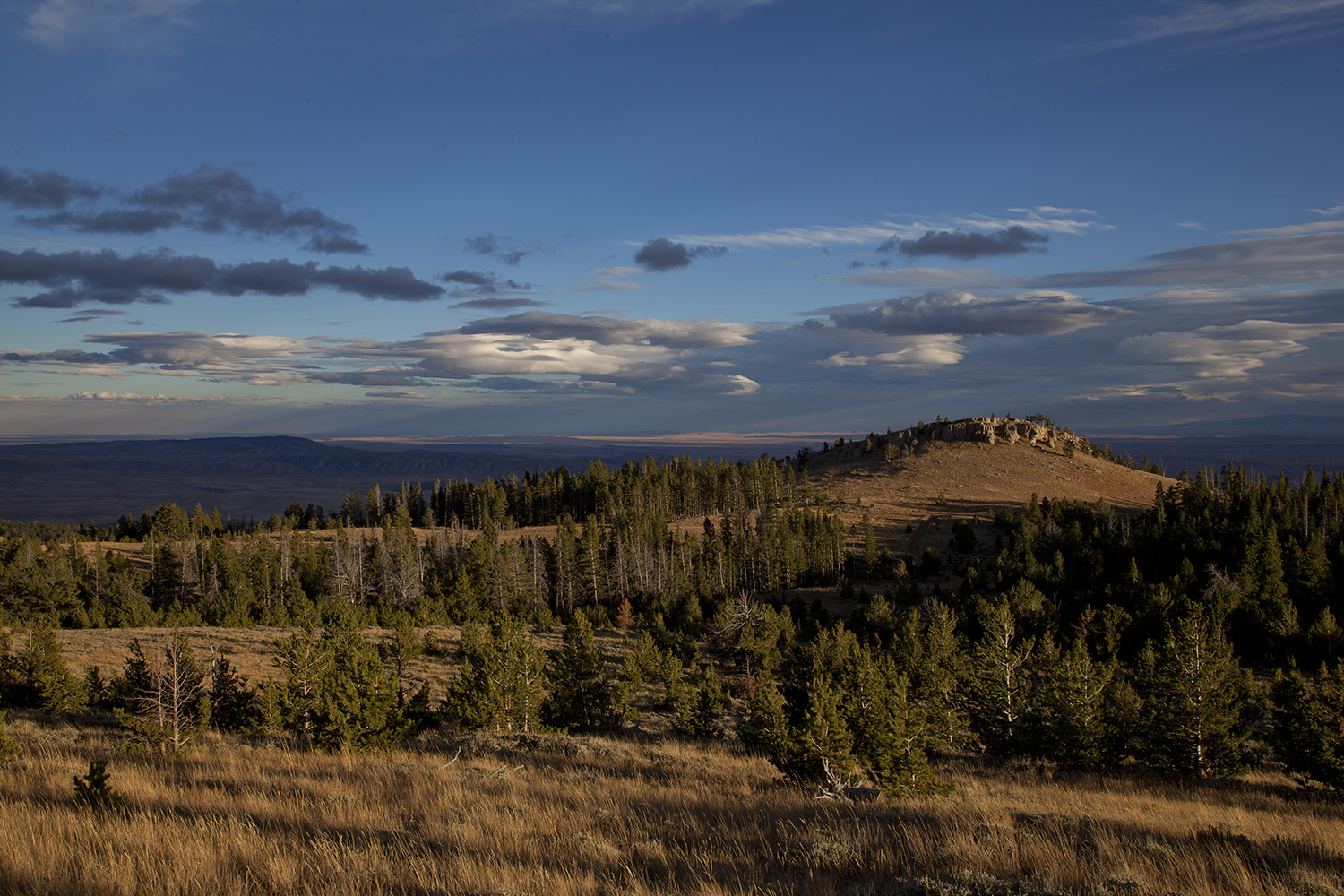
The pursuit of elk in the high West leads to some exceptional places at exceptional moments. There is an esthetic to the hunt that has to be lived to be appreciated. Photo by Chris Madson, copyright 2018, all rights reserved.
RAY FISCHER HAS BEEN A HUNTER EDUCATION INSTRUCTOR IN KANSAS SINCE 1994. HE’S ONE OF THE STATE’S most active volunteers and a member of the International Hunter Education Association’s Hall of Fame. Over his twenty-five years in hunter ed, he’s watched the change up close.
“In the ten to twelve classes we do in this area every year, our demographic for the last ten years has been average age of 20.2. We’re getting older students in our class. Eleven and twelve-year-olds— that’s what we would call our traditional student— we’re getting a few of those, but we’re also getting their mothers or their fathers or their grandfathers.”
It’s a trend that’s taken many observers by surprise.
Fifty years ago, several researchers found that between eighty and ninety percent of all hunters started hunting in their teens.[i] This finding led to a couple of conclusions at the time: first, that kids learned to hunt from their parents or other adult relatives and, second, that people who hadn’t started hunting by the time they were twenty probably never would.
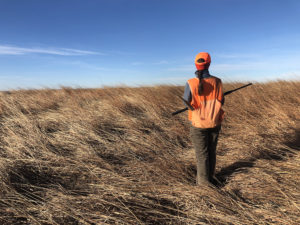
A beginning hunter learning to see country in a different way. Photo by Chris Madson, copyright 2018, all rights reserved.
Not long after this information was collected, wildlife managers discovered a disturbing trend: the number of Americans who hunted had begun to decline. For thirty years after World War II, the number of hunting licenses sold in the United States rose steadily, reaching a peak of 16.7 million in 1982, but in the decade that followed, it dropped by more than a million,[ii] even as the population of the nation as a whole rose by nine percent.
The reasons for the shift were clear enough. More and more people were moving into urban areas, where wild places were hard to come by and the use of any hunting weapon, frowned upon. Added to that was a change in the structure of the American family; in 1960, one child in ten lived in a one-parent family; by 1990, nearly a quarter of all kids were living with a single parent. Nine out of ten of those single parents were moms faced with the demands of running a household and holding down a job.[iii] They had neither the time, the expertise, nor, in most homes, the inclination to introduce their kids to hunting.
The decline in the number of hunters sent a chill down the spine of anyone who followed wildlife conservation in America. The sale of hunting licenses, along with revenue from excise taxes on hunting arms and ammunition, had been a mainstay of funding for state wildlife agencies over the century, and beyond the financial support, hunters had been key players in the politics of conservation— in Congress, in state capitols across the country, and down at the grassroots, not only for game but for the spectrum of wildlife and wild land across the continent. It was clear to anyone in the field that the loss of the hunting tradition would cripple conservation and just as certain that the way to produce more hunters was to work with kids.
Driven by that sense of urgency, state wildlife departments threw ever more weight behind their hunter education programs, and a host of private-sector conservation groups launched outreach efforts to encourage new hunters. Guided by the information developed in the 1970s, the people who ran these programs targeted kids, assuming that anyone over the age of twenty had already made the choice to hunt . . . or not.
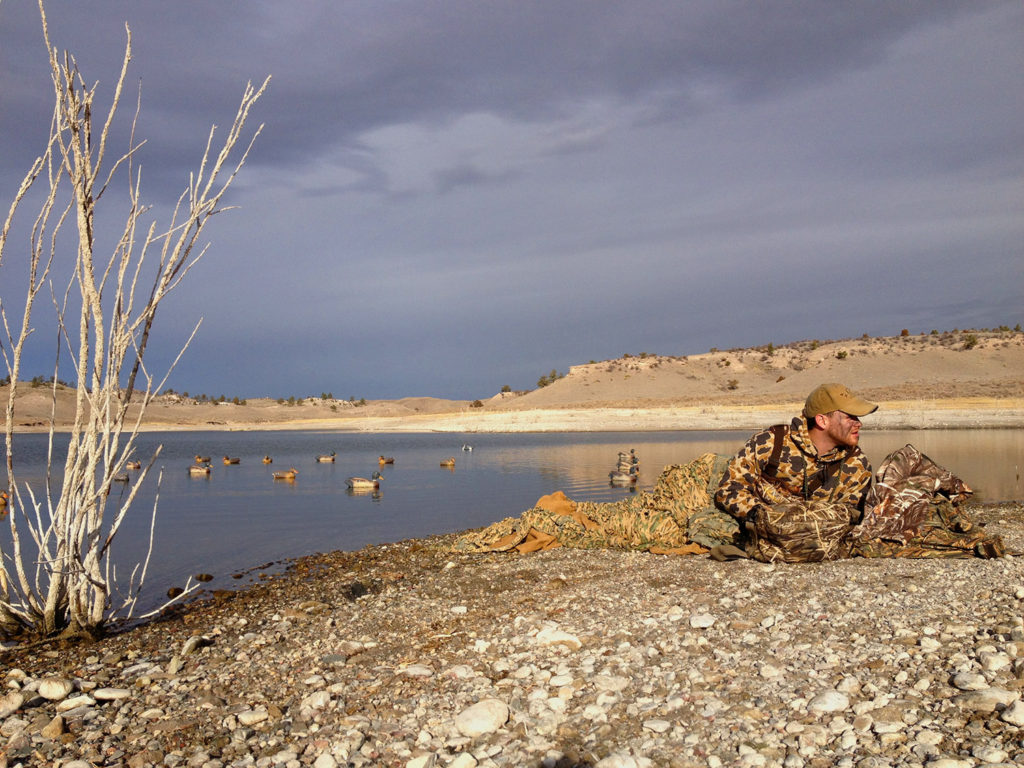
Some kinds of hunting, like waterfowling, are particularly gear- and knowledge-intensive. A mentor can help a beginner master the practical challenges of the hunt and recognize the esthetic and philosophical rewards as well. Photo by Chris Madson, copyright 2014, all rights reserved.
There’s no way of knowing how effective this focus on preteens and teens was in slowing the decline in the number of hunters, but as the years passed, it became clear that programs for kids, by themselves, weren’t turning the tide. There were several obvious reasons for that. In the modern era, kids don’t have the money to buy even the most basic equipment they need to hunt, and without driver’s licenses, they can’t get out of town to places where game can be shot. They are utterly dependent on adults for all that, and the adults in their lives often can’t or won’t provide it. Any number of other activities are easier for a kid to join and easier for an adult to support.
Still, the conservation community concentrated much of its attention on young people, hoping for the best and largely ignoring a crucial shift in attitudes among American adults.
Like most grassroots movements, the modern focus on healthy eating has obscure origins. Upton Sinclair’s1906 novel, The Jungle, may have been the first public expression of American concern over food, but that angst seemed to deepen in succeeding decades. Saccharin, cyclamates, red dye number 2, nitrites, PCBs, mercury, outbreaks of E. coli and Salmonella[iv] became front-page news, leading to the creation of the federal Food Safety and Quality Service (later the Food Safety and Inspection Service) in 1977 to keep watch over meat and poultry production. For a new generation of consumers, the inspection mandate was comforting, but it didn’t allay their deepening concern over nutrition. The “food movement” had been born.
When these activists considered the possible sources of locally grown, organic meat with no hormones or antibiotics, they found themselves drawn to wild game. And so a cohort of hunters was created, not from twelve-year-olds hoping to follow their dads into the field but from twenty- and thirty-somethings who were following an ethical, dietary, and political position to its logical conclusion.
In 2005, a new set of researchers revisited the question that had been asked in the 1970s: At what age do new hunters first take up hunting? And they discovered a seismic shift— a third of new hunters were starting after the age of twenty.[v] Ray Fischer’s observation in central Kansas turned out to be true for the entire nation.
Adults are taking up the hunt for a variety of reasons, recreational as well as practical and political, but one statistic suggests that getting organic red meat is a primary motive. In 2016, federal estimates of the numbers of hunters dropped across the board, but some kinds of hunting suffered more than others. Compared to the long-term average from 1991 through 2011, the number of big game hunters in 2016 dropped sixteen percent while the number of small game hunters dropped thirty-nine percent, and the number in pursuit of migratory birds declined by fifty-one percent.[vi] My guess is that the influx of adult locavores helped support the statistics for big game.
Some of these adult hunters have been self-starters. One of my oldest friends, wildlife biologist Neil Johnson, now retired from the Idaho Department of Fish and Game, is one of those.
“I grew up just outside New York City, on the Jersey side,” he says. “Dad never fished; he never hunted. Mom— she liked cats. I used to read Robert Ruark in Field & Stream and The Old Man and the Boy and that was probably the closest I got to doing anything outside.
“It was my second year in grad school when I decided biophysics wasn’t where I wanted to be, and I transferred up to UMass for wildlife.”
That was where he decided to take up hunting.
“I killed a couple of deer out of Vermont— archery. I got into shorthairs in Massachusetts, and my neighbor gave me a big black Lab. I ended up buying a little side-by-side twenty-gauge Ithaca.”
With the ink still drying on his Ph.D., he took a teaching position at Dakota College in Bottineau, North Dakota, then moved to Kansas and later to Idaho as a state wildlife biologist.
“I couldn’t say that anyone was a mentor,” he says, as he looks back over his decades as a hunter. “I had people I hunted with that were fairly knowledgeable and knew how to do it correctly.”
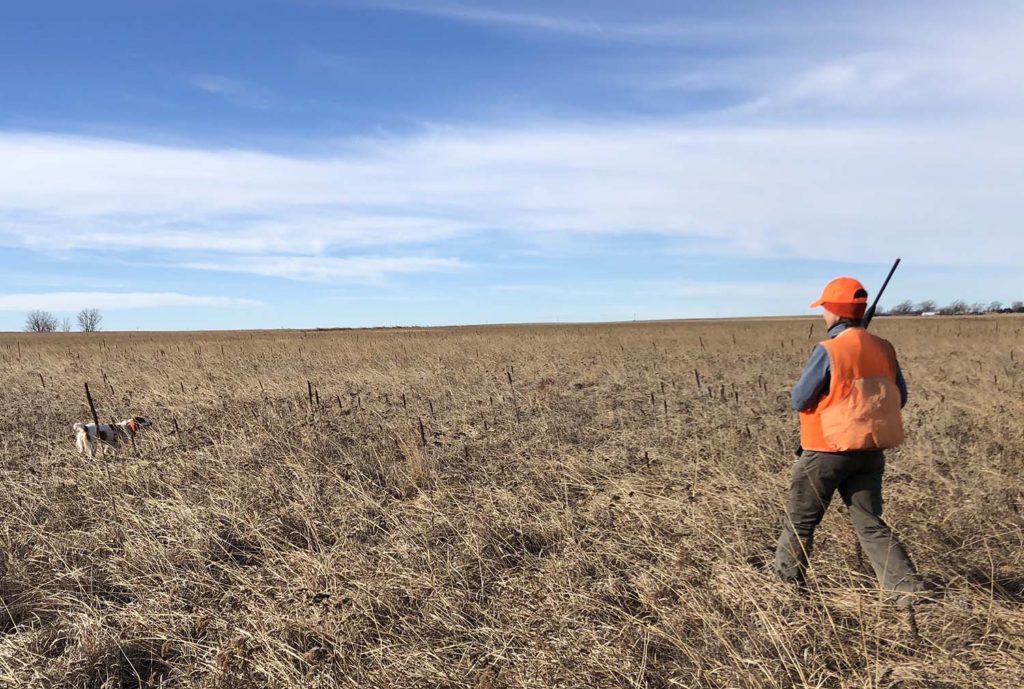
A thirty-something hunter walks in on her first pointed pheasant. Photo by Chris Madson, copyright 2018, all rights reserved.
Heidi Hillhouse is a grassland ecologist with the University of Nebraska whose introduction to hunting was almost as independent.
“My parents divorced,” she remembers, “so I didn’t spend a lot of time around my dad after I was in high school. My mom had done a little bit of hunting with him— at one point, she wounded a rabbit and was totally traumatized by the incident and never hunted again.”
Heidi went off to the university for undergraduate and graduate degrees, but after she launched her professional career, she revisited the idea of hunting.
“I’d wanted to get involved in hunting for quite a while but just never really wanted to jump in and go solo. By coincidence, my sister started dating a guy who did some hunting and offered to help me get started. Now it turns out, he was one of the worst teachers I have ever encountered. It was not a smooth start.”
After three muzzle-loader deer seasons that were long on frigid waiting and short on venison, her volunteer instructor was laid up with hip surgery. She jumped on the opportunity to get out on her own.
“I promptly got a modern rifle with a scope, got another friend to set me up with a place, and got two deer that year. The first time I shot a deer, I was solo.”
With the help of a couple of illustrated books, she taught herself to field-dress deer and decided to handle a lot of the butchering on her own as well.
“The first one I butchered, I didn’t have any help. I really like it because it gives you so much flexibility with what you can do with what you’ve harvested.”
These brave souls are probably the exception among hunters who start as adults. Matt Dunfee is the director of special programs with the Wildlife Management Institute. One of his main interests has been finding ways to shore up the declining population of hunters, and he’s enthusiastic about helping adults take up the discipline. In his experience, “self-starters are rare, and I don’t think there are enough self-starters out there to bolster hunting. There’s an old Japanese proverb— paraphrasing it, it says, ‘If you’re passionate about what you want to do, you’ll teach yourself; if you’re just interested in doing something, you’ll have somebody else teach you.’”
He’s convinced that helping adults who want to start hunting is a smart move.
“They’re a better investment than a kid,” he argues. “They’re motivated by authentic experience and local sustainable living— you tie into their motivations and they’ll find the time and money to do it.”
The organized effort to teach adults how to hunt may well have started in Wisconsin. In 1991, Christine Thomas, a professor at Wisconsin-Stevens Point, launched a program she called Becoming an Outdoors Woman, designed to teach women a variety of outdoor skills, including hunting. It proved immensely popular— today, thirty-eight states and six Canadian provinces offer B.O.W. workshops.[vii]
Jamie Fischer, Ray Fischer’s wife, was less than interested in taking hunting lessons from her husband, but, eight or ten years ago, her daughter-in-law decided to attend a B.O.W. workshop, and Jamie went along.
“I was hooked after that,” she says.
“I love going deer hunting or turkey— to watch nature wake up. Just to go and have that quiet time. To watch who’s out and around and who isn’t around. I love the meat we get that way and the time spent together.”
Another early effort to tailor hunter education to an adult audience was launched at the University of Wisconsin-Madison in 1993. Two professors in the Department of Wildlife Ecology, Scott Craven and Don Rusch, recognized that many of the department’s undergraduate and graduate students had never had an opportunity to hunt. Since hunting remains one of the most important— and controversial— parts of American wildlife management, the profs thought it was vital for these developing wildlife managers to understand something about it. They saw it as an important part of the curriculum for future professionals, but it also turned out to be one of the earliest efforts to teach hunting to adults.
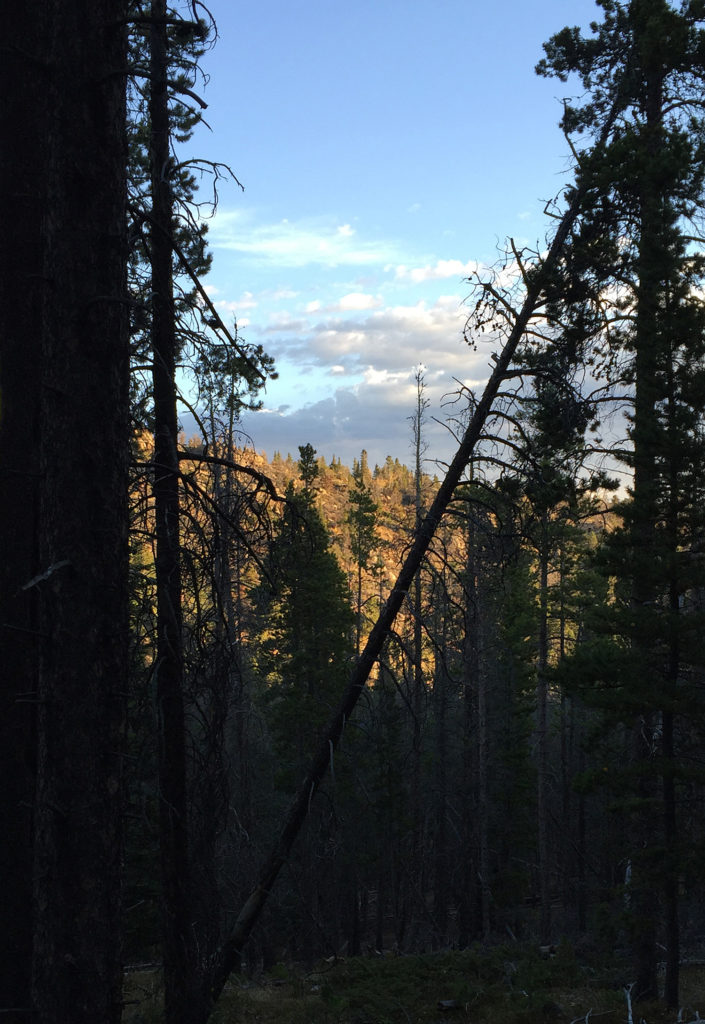
There are some scenes only a hunter is present to witness. Photo by Chris Madson, copyright 2015, all rights reserved.
Their program included a hunter education class and certification, training in the use and safe handling of firearms, roundtable discussions on the relationship between hunting and wildlife conservation, and a day of actual hunting in the field. The Wisconsin Student Hunter Program, as it was called, was adopted by several other university wildlife departments, and in 2005, it was expanded to an even more extensive course of training, Conservation Leaders for Tomorrow.[viii]
These programs at the two state universities stimulated a broader approach to hunter recruitment in Wisconsin. Keith Warnke, a biologist with the Department of Natural Resources, began working on hunter recruitment in the 1990s and took over the position of hunting and shooting sports coordinator in 2011. In 2018, the DNR promoted him to lead its R3 [Recruitment, Retention, Reactivation] Team.[ix]
Warnke emphasizes the connection between the locavore movement and adults taking up hunting for the first time:
“Hunting provides us with that deep connection to our food— local, sustainable, self-gathered, and delicious.” And he’s seen the same shift Ray Fischer has experienced: “These are adults, many of whom have not had any experience with guns or hunting, or shooting. It’s really exciting because you have an invested, motivated learner, somebody who’s just really eager to learn how to hunt.”[x]
About six years ago, Scott Harmon and Mark Gochnour, members of the Izaak Walton League’s Bethesda-Chevy Chase chapter, came to the same conclusion. The chapter had been running a traditional hunter education program designed to meet the state’s requirements, but Scott and Mark recognized the need for a “post-graduate” course.
“We were wanting to pass the knowledge on that we have,” Scott says. “We’ve hunted for years. I’ve bow-hunted since 1982. There’s a lot of knowledge you’d like to pass on and help folks out as they’re first starting out.”
Safety is a key part of the curriculum, but they also delve into the practical knowledge a hunter has to have to be successful.
“We go into the basics of scouting in the woods,” Scott explains. “Tracks, preferred food. Figuring out the ‘why?’ If you can figure out the ‘why,’ you can figure out the ‘when’ and ‘where’ easily. We talk about scent control, wind direction, being proficient, practicing with your firearm, your crossbow, your bow.”
It’s proven to be a popular seminar. Scott says, “We have some younger children who come through, but it’s mostly adults, eighty-twenty, ninety-ten, depending on the class.”
Bit by bit, state wildlife agencies have begun efforts to expand their hunter education to meet the needs of adults. The Wisconsin Department of Natural Resources has developed an extensive outreach effort aimed at adult hunters, online and in the field. Much more recently, the New Mexico Department of Game and Fish recognized that their hunter numbers were dropping and decided to take a new approach to recruitment.
Lance Cherry, chief of Information and Education for the New Mexico Department, remembers that time.
“In 2011, we dropped eleven percent” in license sales, he says. “That was absolute rock bottom. The bulk of our buyers were still baby boomers— our primary customer was aging out of the sport.”
Cherry says that they completely revamped the department’s hunter education program. “We started requiring some responsible adult to come with those kids to those programs.” Cherry and his staff could see that “the parents didn’t have the skill sets we were trying to give the kids. We started sneaking that in.”
As the parents built their own skills, the demand for more sophisticated classes grew. The department launched a cooperative program with the Mule Deer Foundation to reach out to adults, especially parents.
“There are a lot of single moms out there,” Cherry says. “We built a program that encourages them to go to the extremes. We’re going to teach you how to hunt and how to field dress. To be successful in these things.”

Wyoming’s hunter education instructors gather for a group photo after two days of meetings to hone their skills. Hunter education in the modern era should reach out to beginning adults as well as kids.
After that, the department expanded its outreach even further.
“We’ll do those specific kinds of hunter ed classes where it’s just adults that come in,” Cherry adds. “They’re not required, but you’d be amazed how many adults want to go do that so they know enough to be those role models for their own kids.”
The result? Sales of hunting licenses in New Mexico rose from 66,000 in 2011 to 115,000 in 2017. Cherry sees most of the growth in two age groups: “youth, eight to eighteen, and adults, around twenty-eight to forty.”
There is, in this resurgence of interest among adults, great reason for hope. It shows us that hunting is more than a child’s pursuit. It’s a way of understanding the world that gains meaning rather than losing it, as we spend more and more of our lives in cages of our own making. There is really only one reality, and it’s not virtual. The new generations of hunters have recognized that fact. They’re reaching out, reaching back, to connect with the earth in the most intimate, most serious way.
All they need is a guide.
——————-
[i] pp.105-106, Applegate, J.E., 1977. Dynamics of the New Jersey hunter population. In: Transactions of the Forty-second North American Wildlife and Natural Resources Conference. Wildlife Management Institute, Washington, D.C.
[ii] Data extracted from: U.S. Fish and Wildlife Service National Hunting License Report, 2004-2015, accessed May 21, 2019: https://wsfrprograms.fws.gov/Subpages/LicenseInfo/HuntingLicCertHistory20042015.pdf. U.S. Fish and Wildlife Service National Hunting License Report, 1958-2003: https://wsfrprograms.fws.gov/Subpages/LicenseInfo/HuntingLicCertHistory.pdf. And the 2016 and 2017 U.S. Fish and Wildlife Service National Hunting License reports.
[iii] Living arrangements of Children Under 18 years old: 1960 to Present. U.S. Bureau of the Census. https://wsfrprograms.fws.gov/Subpages/LicenseInfo/HuntingLicCertHistory20042015.pdf. Accessed May 21, 2019.
[iv] Pollan, Mchael, 2010. The Food Movement, Rising. The New York Review of Books. https://michaelpollan.com/articles-archive/the-food-movement-rising/. Accessed May 21, 2019.
[v] p.5. Leonard, Jerry, 2007. Fishing and hunting recruitment and retention in the U.S. from 1990 to 2005. Report 2001-11, U.S. Fish and Wildlife Service, Arlington, VA.
[vi] Data from these reports: p. 32, 1996 National Survey of Fishing, Hunting, and Wildlife Associated Recreation. p.33, 2006 National Survey of Fishing, Hunting, and Wildife-Associated Recreation. p. 35, 2016 National Survey of Fishing, Hunting, and Wildlife-Associated Recreation, all from U.S. Department of the Interior, Fish and Wildlife Service and U.S. Department of Commerce, Bureau of the Census.
[vii] Becoming an Outdoors-Woman. https://www.uwsp.edu/cnr-ap/bow/Pages/States-and-Provinces-offering-BOW.aspx. Accessed May 23, 2019.
[viii] Barrow, Lori, 2017. A different kind of education. https://forestandwildlifeecology.wisc.edu/2017/06/05/a-different-kind-of-education/. Accessed May 23, 2019.
[ix] Anon., 2018. Keith Warnke hired as Wisconsin DNR R3Team supervisor. https://dnr.wi.gov/news/Weekly/article/?id=4176. Accessed May 23, 2019.
[x] Milewski, Todd, 2014. Q&A: Keith Warnke says local food movement and hunting are a natural fit. The Capital Times, Nov. 16, 2014. https://madison.com/ct/news/local/writers/todd-milewski/q-a-keith-warnke-says-local-food-movement-and-hunting/article_d8087439-3bd2-519f-8a9d-7c9eadfe8ce2.html. Accessed May 23, 2019.
Leave a Reply
You must be logged in to post a comment.